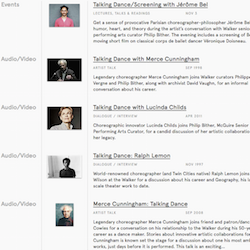Walker Recipe 8: Talking Dance Lectures
Navigation Menu
- Advocacy Resources
- Artist’s Legacy Toolkit
- Audience Engagement Strategies
- Building Audiences for the Arts: Research and Resources
- Coronavirus Resources
- Dance/USA Fellowships
- Dance/USA Task Force on Dancer Health
- Equitable Contracting Resources
- Funding Resources
- Harassment in the Workplace Resources
- Jobs, Auditions, & Internships
- Key Advocacy Issues
- Music and Choreography Resources
- Mentorship Program: Dance/USA Institute for Leadership Training
- Request a Peer Consultation Letter
- Scheduling Congressional Visits
-
 Organization Name: The Walker Art Center
Organization Name: The Walker Art Center
City: Minneapolis
Program Name: Talking Dance Lectures
Time of Program: Evenings
Program Length: Evening Length (about 1.5 to 2 hours)
Program When Elaborate: Not offered directly at a performance but is offered in conjunction with a live performance of the artist’s work, typically the week of the performances.
Goal: This pre-show series aims to expand audience engagement through lectures that focus on the dance artist presenting work. This is part of Walker’s effort to connect all programs through common audience engagement threads, focusing on developing scalable, replicable models to engage audiences before, during, and after performances.
Time of Year Offered: Year-round throughout the run of the season
Program Description:
The Walker’s Talking Dance lectures are conversations led by a facilitator, open to the public, where choreographers/dance artists speak about their work, in dialogue with a scholar or expert staff member. The name “Talking Dance” is meant to brand the lecture series and contextualize the lecture around choreographers. The lecture is followed by a Q&A with the audience. Talking Dance lectures differ from post-show Q&As because of their extended length, use of other materials such as audio/video, and thorough attention to a dance artist (often their entire career). Each Talking Dance lecture is videotaped and archived on the Walker Channel, YouTube, and iTunesU for free viewing.
Number of Participants: The average is 48 people.
Target Audience: The Walker often extend invitations to dance departments in order to build an audience in advance, trying to draw students from colleges or universities if their professors are not already planning to attend. While these are “lectures,” they are geared towards audience members at all interest levels.
Private/Public Public
Nature of Audience Engagement: Audience members attend the live discussions and ask questions, or they view the videotapes of the events.
Location: The Talk Dance lectures take place at the Walker Art Center.
How Many Staff: Staff members required include a scholar/informed staff member, the choreographer or artists, and the facilitator. Sometimes, there are additional panelists too, depending on the topic and who from the company/Walker staff is on stage.
Attendance To Date: Our two Talking Dance lectures since the EDA grant period began averaged 48 persons in attendance.
Past Iterations: The program has been carried out two times during the EDA Round one grant period but the Talking Dance lectures existed as a program since 2001.
What works? Scheduling and presenting the lecture in conjunction with a live performance of the artist’s works—usually the week of and not the same day as the performance—expands your audience’s engagement.We often extend invitations to dance departments in order to build an audience in advance, trying to draw students from colleges or universities if their professors are not already planning to attend. While these are “lectures,” they are geared towards audience members at all interest levels. These evening-length programs have nearly always been free.
What doesn’t work? It is difficult to convince audiences to come out two nights in one week to support the same project, which means attendance has tended to be low.
Performances Where Offered: Talking Dance Lectures are more difficult to do outside of a dance residency, so they’re done with a company who is already in town.
Past Research on Program: Walker’s EDA-related research included distributing surveys to measure differences in audience’s engagement with the performance, comparing those who participated in Walker’s array of EDA-sponsored activities versus those who did not participate with positive results for those who did participate in the survey. This research was across various types of events, so is not specific to the Talking Dance Lectures. engagement activities—particularly post-performance, or a combination of post-performance and online activity, resulted in significantly stronger reports of impact (captivation, feeling challenged, emotional and spiritual resonance, connecting with the dancers on stage, connecting with the audience, and the impression left by the performance) compared to those who did not participate in any engagement activities.
Continuing Program? Yes but we are offering them less frequently. Usually they are attached to a dance performance.
Additional Comments:
These types of facilitated conversations are easily adapted to a panel discussion if there is a broader topic, or can be made more personal to the artist’s history, latest creation, or current aspirations. Also, video documentation can help to further the artist’s work or become a resource for the field at a later date. Lectures of this type are a great opportunity to partner with dance departments at colleges, universities or other humanities-based organizations.
Resources & Links:
Please see the information about the Walker Art Center and its recipe book on the Dance/USA website
Read a profile about the project, and access related products, including the Recipe Book: https://www.danceusa.org/walkerartcenter
See a resource guide about the project, and view videos from Walker staff about it: https://www.danceusa.org/edalearningexchangescontent
